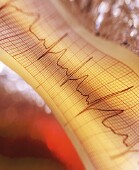
MONDAY, Dec. 19 (HealthDay News) — Snipping certain nerves may help prevent dangerous heart rhythms caused by stress, a small, new study suggests.
An adrenalin-driven “fight or flight” stress reaction in response to danger is normal, but this reaction is abnormally strong in some people and can lead to excessive sweaty palms (hyperhidrosis) and irregular heart rhythms called ventricular arrhythmias, which originate in the lower chambers of the heart.
Now, a team of cardiologists at the University of California, Los Angeles has found that snipping nerves related to the sympathetic nervous system on both the right and left sides of the chest may help prevent these ventricular arrhythmias, also referred to as “electrical storms.”
Ventricular arrhythmia kills 400,000 people in the United States each year and is a leading cause of death in the nation, according to a UCLA Health Sciences news release. Treatments include medications, an implantable cardioverter defibrillator and a procedure called catheter ablation, which provides a targeted burn to the tiny area of the heart that causes the irregular heartbeat.
“When these treatment options fail, especially for a patient experiencing a life-threatening electrical storm, the situation becomes critical. We are always seeking additional options to help patients,” senior study author Dr. Kalyanam Shivkumar, director of the UCLA Cardiac Arrhythmia Center and co-director of the Oppenheimer Family Center for Neurobiology of Stress at UCLA, said in the news release.
The new procedure, called a bilateral cardiac sympathetic denervation, was performed on six patients. After the surgery, four of the patients had a complete response and no longer experienced arrhythmias, one patient had a partial response, and one had no response.
One cardiologist said the nerve snip may have a place in caring for arrhythmias.
“Autonomic influences on the cardiac rhythm may be very potent and their subsequent manipulation to aid in rhythm management have been utilized for several years,” said Dr. Larry Chinitz, director of the Heart Rhythm Center at NYU Langone Medical Center in New York City. He called the new procedure “an innovative use of this surgical technique and one that may prove to be a potent adjunct to currently available therapies.”
The study, which was funded by the U.S. National Institutes of Health, appears in the Dec. 27/Jan.3 issue of the Journal of the American College of Cardiology.
More information
The American Academy of Family Physicians has more about arrhythmias.

